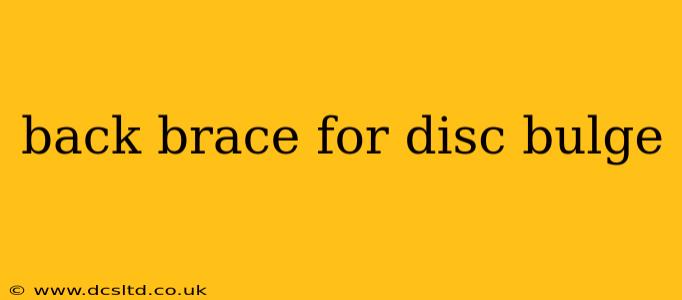A bulging disc, a common cause of lower back pain, occurs when the soft, gel-like center of an intervertebral disc pushes against the outer layer, causing irritation and pain. While many cases resolve with conservative treatment, a back brace can provide significant relief and support. This guide explores the role of back braces in managing disc bulges, helping you understand how to choose the right one and what to expect from this type of support.
What is a Disc Bulge?
Before diving into back braces, let's briefly clarify what a disc bulge is. It's a condition where the outer layer of the intervertebral disc (the annulus fibrosus) weakens, allowing the inner part (the nucleus pulposus) to bulge outwards. This bulge can put pressure on nearby nerves, leading to pain, numbness, tingling, or weakness radiating down the leg (sciatica). The severity varies greatly, and some people experience minimal symptoms while others have debilitating pain.
Types of Back Braces for Disc Bulges
Several types of back braces can be beneficial for managing disc bulge pain. The best choice depends on the individual's specific needs, the severity of their condition, and their doctor's recommendations. Common types include:
-
Lumbar Supports: These braces provide gentle support to the lower back, helping to improve posture and reduce strain on the affected discs. They are often recommended for mild to moderate disc bulges. They are usually flexible and comfortable for everyday wear.
-
Rigid Back Braces: These offer more substantial support and stabilization, limiting the range of motion in the spine. They are often prescribed for more severe disc bulges or after surgery to promote healing and prevent further injury. These are less comfortable for extended wear.
-
Sacroiliac (SI) Joint Belts: While not directly targeting the disc, these braces support the sacroiliac joints, which are located where the spine meets the pelvis. Pain in this area can often be associated with disc bulges, and stabilizing the SI joint can help reduce overall back pain.
-
Corsets: These provide comprehensive support to the entire torso, offering significant stability and pain relief. They are generally used for more severe cases or during recovery from surgery.
How Can a Back Brace Help with a Disc Bulge?
A back brace offers several benefits for managing a disc bulge:
-
Pain Relief: By providing support and limiting movement, a back brace can reduce pressure on the bulging disc and irritated nerves, alleviating pain.
-
Improved Posture: Proper posture helps to reduce strain on the spine and can minimize pressure on the affected disc.
-
Muscle Support: A brace can assist weakened back muscles, reducing their workload and preventing further injury.
-
Stabilization: Rigid braces provide significant spinal stability, especially important during healing after surgery or for severe disc bulges.
What are the Different Types of Materials Used in Back Braces?
Back brace materials vary widely, impacting comfort, support, and breathability. Common materials include:
-
Neoprene: Offers good compression and warmth, which can be soothing for muscle aches. However, it can be less breathable than other materials.
-
Polyester and Nylon blends: These are lightweight, breathable, and often used in flexible lumbar supports.
-
Rigid Plastics or Metals: Used in rigid braces for superior support and stabilization.
Does a Back Brace Cure a Disc Bulge?
No, a back brace does not cure a disc bulge. It's a supportive measure to manage pain and promote healing. The underlying disc problem requires a comprehensive treatment approach, often including physical therapy, medication, and lifestyle modifications. A back brace is a crucial part of this plan, but not the sole solution.
When Should I See a Doctor About My Disc Bulge?
You should consult a doctor if you experience:
- Severe or persistent back pain.
- Pain that radiates down your leg.
- Numbness or weakness in your leg or foot.
- Loss of bowel or bladder control.
What Other Treatments are Available for a Disc Bulge?
Treatment for a disc bulge depends on the severity and symptoms. Options include:
- Physical Therapy: Exercises to strengthen core muscles and improve flexibility.
- Medication: Pain relievers, muscle relaxants, or anti-inflammatory drugs.
- Injections: Epidural steroid injections to reduce inflammation.
- Surgery: In severe cases, surgery may be necessary to repair or remove the damaged disc.
A back brace is often used in conjunction with these other treatments to maximize pain relief and promote healing. Always consult your physician or physical therapist to determine the best course of action for your specific situation. They can help you choose the most appropriate back brace and integrate it into your overall treatment plan.
